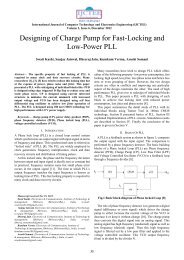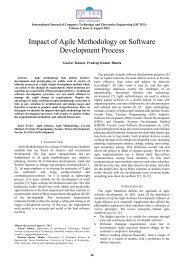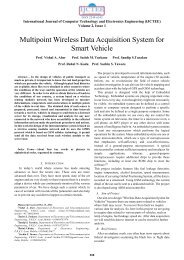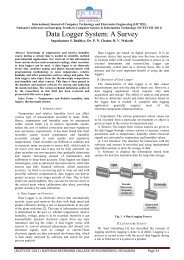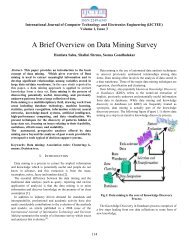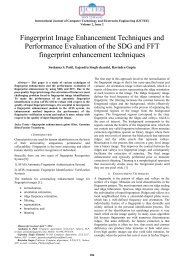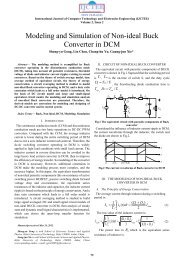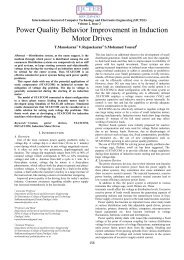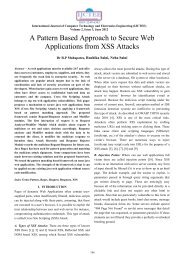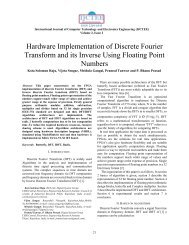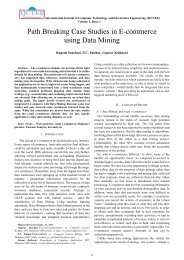Effect of Turbo Coding on OFDM Transmission to Improve BER
Effect of Turbo Coding on OFDM Transmission to Improve BER
Effect of Turbo Coding on OFDM Transmission to Improve BER
You also want an ePaper? Increase the reach of your titles
YUMPU automatically turns print PDFs into web optimized ePapers that Google loves.
Here A = turbo encoder, B = QAM/QPSK modulati<strong>on</strong>, C =<br />
serial <strong>to</strong> parallel c<strong>on</strong>verter, D = IFFT, E = parallel <strong>to</strong> serial<br />
c<strong>on</strong>verter, F = channel with noise, G = serial <strong>to</strong> parallel<br />
c<strong>on</strong>verter, H = FFT, I = parallel <strong>to</strong> serial c<strong>on</strong>verter, J =<br />
AM/QPSK demodulati<strong>on</strong> and K = turbo decoder.<br />
A. Simulati<strong>on</strong> Parameters<br />
During the simulati<strong>on</strong>s, in order compare the results, the<br />
same random messages were generated. For thet radiant<br />
functi<strong>on</strong> is in MATLAB.<br />
Table 3.4 Simulati<strong>on</strong> Parameters<br />
Parameters<br />
Values<br />
QPSK,16-QAM 64-<br />
Digital Modulati<strong>on</strong><br />
QAM<br />
<str<strong>on</strong>g>Turbo</str<strong>on</strong>g> code rates<br />
½<br />
SISO Decoder<br />
Log-MAP<br />
Code Genera<strong>to</strong>r {111, 101}<br />
Interleaver Size 1 x 100<br />
B. Algorithm <str<strong>on</strong>g>of</str<strong>on</strong>g> Simulati<strong>on</strong><br />
We measured the performance <str<strong>on</strong>g>of</str<strong>on</strong>g> the turbo coded<br />
<strong>OFDM</strong> through MATLAB simulati<strong>on</strong>. The simulati<strong>on</strong><br />
follows the procedure listed below:<br />
1. Generate the informati<strong>on</strong> bits randomly.<br />
2. Encode the informati<strong>on</strong> bits using a turbo encoder with<br />
the specified genera<strong>to</strong>r matrix.<br />
3. Use QPSK or different QAM modulati<strong>on</strong> <strong>to</strong> c<strong>on</strong>vert the<br />
binary bits, 0 and 1, in<strong>to</strong> complex signals (before these<br />
modulati<strong>on</strong> use zero padding)<br />
4. Performed serial <strong>to</strong> parallel c<strong>on</strong>versi<strong>on</strong>.<br />
5. Use IFFT <strong>to</strong> generate <strong>OFDM</strong> signals, zero padding is<br />
being d<strong>on</strong>e before IFFT.<br />
6. Use parallel <strong>to</strong> serial c<strong>on</strong>ver<strong>to</strong>r <strong>to</strong> transmit signal<br />
serially.<br />
7. Introduce noise <strong>to</strong> simulate channel errors. We assume<br />
that the signals are transmitted over an AWGN channel.<br />
The noise is modeled as a Guassian random variable with<br />
zero mean and variance σ2 . The variance <str<strong>on</strong>g>of</str<strong>on</strong>g> the noise is<br />
obtained as<br />
generate a sequence <str<strong>on</strong>g>of</str<strong>on</strong>g> normally distributed random<br />
numbers, where randn has zero mean and 1 variance. Thus<br />
the<br />
received signal at the decoder is :X‟ = noisy (X)Where<br />
noisy (X) is the signal corrupted by noise.<br />
8. At the receiver side, perform reverse operati<strong>on</strong>s <strong>to</strong><br />
decode the received sequence.<br />
9. Count the number <str<strong>on</strong>g>of</str<strong>on</strong>g> err<strong>on</strong>eous bits by comparing the<br />
decoded bit sequence with the original <strong>on</strong>e.<br />
10. Calculate the <strong>BER</strong> and plot it[1].<br />
perfectly known). It is shown, however, that there is a<br />
large potential gain in using the iterative property <str<strong>on</strong>g>of</str<strong>on</strong>g> turbo<br />
decoders where s<str<strong>on</strong>g>of</str<strong>on</strong>g>t bit estimates are used <strong>to</strong>gether with<br />
the known pilot symbols. The performance <str<strong>on</strong>g>of</str<strong>on</strong>g> such an<br />
iterative estimati<strong>on</strong> scheme proves <strong>to</strong> be <str<strong>on</strong>g>of</str<strong>on</strong>g> particular<br />
interest when the channel is str<strong>on</strong>gly frequency- and<br />
time- selective [1].<br />
Similar <strong>to</strong> every other communicati<strong>on</strong>s scheme, coding<br />
can be employed <strong>to</strong> improve the performance <str<strong>on</strong>g>of</str<strong>on</strong>g> overall<br />
system. Several coding schemes, such as block codes,<br />
c<strong>on</strong>voluti<strong>on</strong>al codes and turbo codes have been<br />
investigated within <strong>OFDM</strong> systems. Moreover, the deep<br />
fades in the frequency resp<strong>on</strong>se <str<strong>on</strong>g>of</str<strong>on</strong>g> the channel cause<br />
some groups <str<strong>on</strong>g>of</str<strong>on</strong>g> subcarriers <strong>to</strong> be less reliable than other<br />
groups and hence cause bit errors <strong>to</strong> occur in bursts rather<br />
than, independently . The burst errors can extensively<br />
degrade the performance <str<strong>on</strong>g>of</str<strong>on</strong>g> coding. To solve this<br />
problem several ways are c<strong>on</strong>sidered. The easiest method<br />
is <strong>to</strong> use str<strong>on</strong>ger codes, in fact an interleaving technique<br />
al<strong>on</strong>g with coding can guarantee the independence am<strong>on</strong>g<br />
errors by affecting randomly scattered errors. We use<br />
turbo code <strong>to</strong> improve the performance. For analysis <str<strong>on</strong>g>of</str<strong>on</strong>g><br />
the <strong>OFDM</strong> system, First we examine uncoded situati<strong>on</strong><br />
and then we will analyze the effect <str<strong>on</strong>g>of</str<strong>on</strong>g> coding under turbo<br />
coded <strong>OFDM</strong> c<strong>on</strong>diti<strong>on</strong> [1]-[2]-[6].<br />
As menti<strong>on</strong>ed before, bursty errors deteriorate the<br />
performance <str<strong>on</strong>g>of</str<strong>on</strong>g> the any communicati<strong>on</strong>s system. The burst<br />
errors can happen either by impulsive noise or by deep<br />
frequency fades. Powerline channels suffer from both <str<strong>on</strong>g>of</str<strong>on</strong>g><br />
these deficiencies. “Figure 11” shows the performance <str<strong>on</strong>g>of</str<strong>on</strong>g><br />
uncoded <strong>OFDM</strong> system with AWGN and impulsive noise<br />
(which is modeled as marcov noise). In this “Figure 11” it<br />
is shown that, for the required <strong>BER</strong> 10 -3 AWGN channel<br />
gives better performance as compared with marcov<br />
channel. AWGN gives a gain <str<strong>on</strong>g>of</str<strong>on</strong>g> approximately 22 db over<br />
marcov channel. We observe a little gain at lower SNR<br />
between 0 <strong>to</strong>





